10 Best Cloud Collaboration Tools in 2024: Increase Your Team’s Productivity
Businesses use cloud collaboration tools to streamline their work and improve team productivity. These tools have many benefits, including scalability, manageability, accessibility and integration with other tools for easy communication.
With remote working still ascendant after the pandemic’s business disruptions, cloud collaboration tools continue to be highly effective for business productivity. Beyond allowing teams to share their ideas and work in real time, they also allow team members to reach their customers without financial or geographic boundaries.
Key Takeaways:
- Sync.com is the best cloud collaboration and storage tool, with great security.
- Microsoft Office 365 is the best productivity collaboration tool.
- Slack and Microsoft Teams are both good recommendations for chat-focused team collaboration.
- Google Drive and OneDrive are great alternatives for Sync.com, with impressive storage capacities and plans.
Cloud collaboration tools provide a platform for teams to share, discuss and collaborate on their projects. You can use them to store files and manage tasks, with the functionality to assign tasks, schedule and manage meetings, and keep everyone updated on their progress.
As an added benefit, online collaboration tools can help reduce paper waste and save your company money. They prevent information overload by providing a centralized hub for document and file storage. Since online collaboration tools are accessible from anywhere, they can also help improve your company’s productivity by enabling employees to work from home or while traveling.
-
12/01/2022 Facts checked
Updated to provide two curated lists of the top five productivity and the top five cloud storage tools.
What Makes the Best Cloud Collaboration Tools?
With collaboration apps having many similar features and integrating with a lot of other productivity tools, it might be difficult to choose the right one for your team. We’ve put together a list of our top picks to make your choice easier.
5 Best Productivity Tools
First up, we have five tools that help increase productivity by facilitating communication and collaboration.
- Microsoft Office 365 — The best productivity-based collaboration tool
- Google Workspace — Share and work on documents live with messaging
- Slack — Powerful collaborative chat application
- Microsoft Teams — Flexible project collaboration chat app
- Google Meet — Google’s video collaboration tool
5 Best Cloud Storage Tools
Next are five cloud storage solutions that lend themselves to file sharing and collaboration.
- Sync.com — The best cloud storage for collaboration
- Box — Advanced cloud storage with API features
- Dropbox — Scalable online storage for businesses
- Google Drive — Best free cloud storage for collaboration
- Microsoft OneDrive — Super compatible with Windows
The reason we’ve chosen to separate productivity tools from cloud storage tools is because they have different feature sets and purposes.
Cloud storage tools are useful for storing large files and are great for collaboration because they allow users to access files through a browser. By comparison, productivity tools aid with the creation of files and documents that are usually smaller in size but can be easily managed by their own applications, without having to upload them to the cloud.
Together, they make for better overall cloud-based collaboration, since users can access documents faster, saving the time it would take to manage large files on their personal local systems.
Cloud Collaboration Tools: Traits We Look For
There are many factors that make a great cloud collaboration tool. You need to be able to communicate, share data and files, and collaborate with your team. You also need security and privacy controls, so you can manage who has access to what. Finally, the tool should work well on any device or operating system.
It’s important for team collaboration software to meet all your team’s online communication needs, from basic document emailing and file sharing to video conferencing and advanced project management tools. We looked at the key features like internal chat, file uploads and storage, and distributed teams to identify the best collaboration platforms.
Our top picks give you more flexibility than traditional email and Excel for sharing files, providing one-click access to everything you need so you can work faster. We also looked at security and data protection, as well as integrations with other business software. The best collaboration tools are also secure by default, with strong encryption and access-control features.
The 5 Best Productivity Tools for Collaboration
Keeping track of all the files, messages and tasks that come in each day is a lot easier with the right software. Here are five great tools you can use to keep your team productive as they collaborate together:
1. Microsoft Office 365
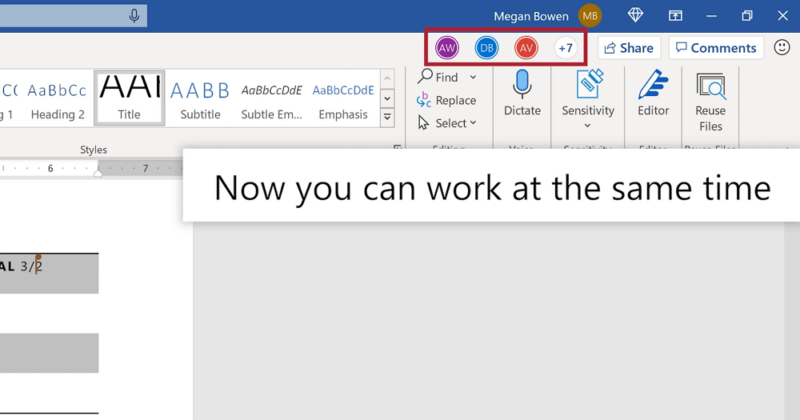
More details about Microsoft Office 365:
- Pricing: From $6 per user per month
- Provider website: office.com
Pros:
- Smooth Windows integration
- Simple file sharing & editing
- OneDrive integration
Cons:
- No zero-knowledge security
- File versioning is limited
Microsoft Office 365 has a great set of collaboration features to improve productivity. These features include shared mailboxes, centralized administration and high availability. It combines the power of five Microsoft tools — like the cloud-based versions of Word, Excel, PowerPoint, OneNote and Outlook — which enable you to create and share documents quickly.
You can also stay up to date on what others are working on by attaching files to a conversation in Outlook or sharing them via OneDrive. Microsoft 365 has every possible variation for online collaboration, including Windows and Mac applications that can be used with Android and iOS mobiles.
Microsoft Office 365 plans are available both in free and paid versions. The free version offers limited storage and usability, while the paid plans provide you with more storage and the full functionality of the MS Office suite.
| Plan: | Price |
|---|---|
| Business Basic | $6 per user per month |
| Business Standard | $12.50 per user per month |
| Business Premium | $22 per user per month |
2. Google Workspace
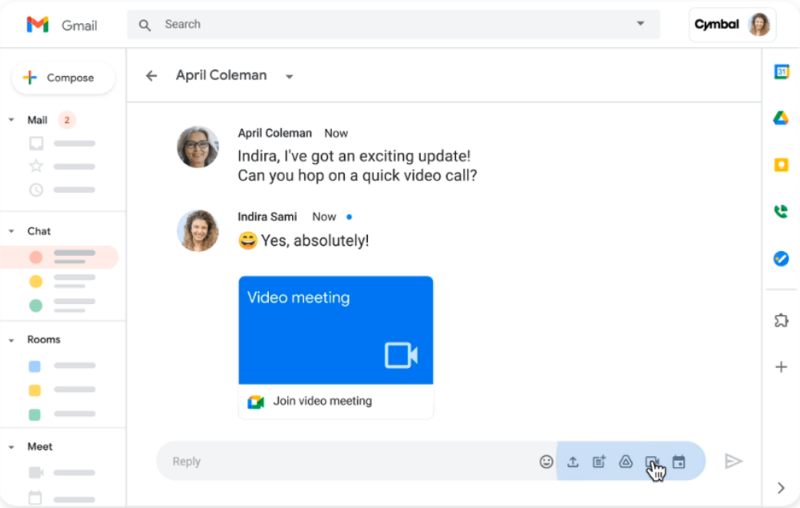
More details about Google Workspace:
- Pricing: Starts at $6 per user per month
- Provider website: workspace.google.com
Pros:
- Permission & role-based sharing
- Among the best document editors
- Completely free
Cons:
- More susceptible to scams/hacking
- No password protection for shared links
Google Workspace offers several features that make it a great productivity tool for collaboration. Its unique features, such as instant messaging, file sharing and mobile document access, make it one of the best team messaging apps.
Cloud collaboration in Google Workspace is as easy as using Microsoft products, with the addition of Google’s own collaboration features. You can work together in real time on documents, spreadsheets and presentations, and create custom spaces to share with coworkers.
Google Workspace comes with reasonable pricing. There’s a free version that allows you to try everything and get your work started, but with limited storage and usability. For advanced usage and higher file storage capacity, opt for one of the paid plans. You can give the paid plans a try first through the 14-day free trial.
| Plan: | Price | Storage | Users |
|---|---|---|---|
| Business Starter | $6 | 30GB | 300 |
| Business Standard | $12 | 2TB | 300 |
| Business Plus | $18 | 5TB | 300 |
| Enterprise | Contact Google | Unlimited | Unlimited |
3. Slack
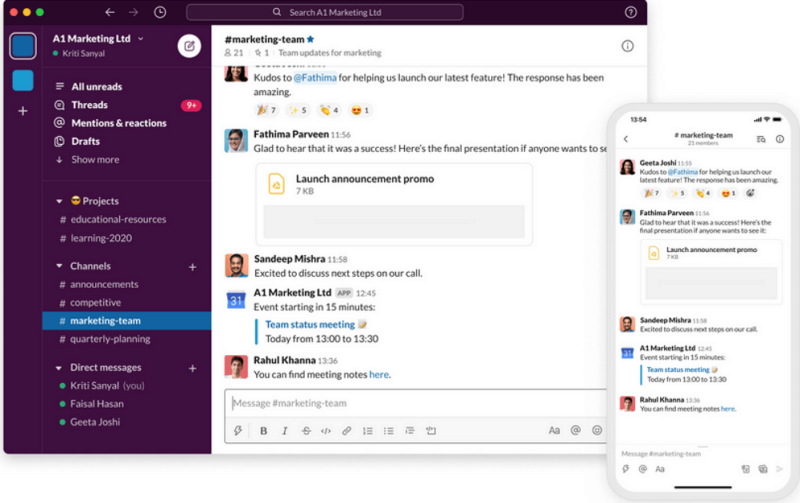
More details about Slack:
- Pricing: Free plan available; Paid plans start at $7.25 per user per month.
- Provider website: slack.com
Pros:
- Incredible free plan
- Feature packed
- Lots of integrations
Cons:
- Expensive paid plans
- Low quality audio & video calls
Slack is a chat and collaboration tool with unique features that make it one of the best online collaboration tools. Features like dedicated channels for specific projects, custom emojis and pins, and direct message integration with all other apps help teams stay organized, on track and productive.
It has a simple user interface, which makes it easy for people of all skill levels to use. It also offers many features you won’t find elsewhere, such as direct message integrations with other apps like monday.com or Asana.
Slack is available for free with limited storage space. The ability to view and search messages and files on Slack’s free plan is also limited to the last 90 days. The paid versions allow you to take control of its full arsenal of powerful integrations.
| Plan: | Price (monthly) | Price (yearly) |
|---|---|---|
| Free | $0.00 | $0.00 |
| Pro | $8.75 | $7.25 ($87) |
| Business+ | $15 | $12.50 ($150) |
| Enterprise Grid | Custom | Custom |
4. Microsoft Teams
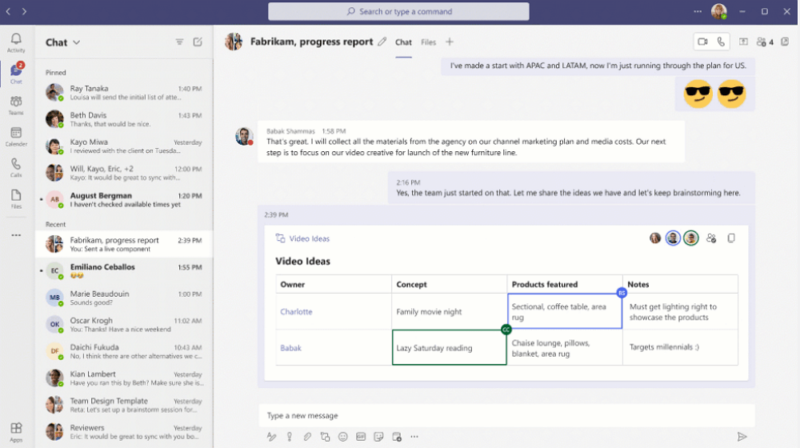
More details about Microsoft Teams:
- Pricing: Free plan available; Paid plans start at $4 per user per month.
- Provider website: microsoft.com
Pros:
- Excellent value
- Native integration with Microsoft apps
- Preinstalled with Microsoft 365
Cons:
- Confusing file structure
- Limited to Microsoft apps
Microsoft Teams is a great productivity tool for collaboration that helps teams stay connected. One of the most impressive features is Teams’ deep integration with the Office 365 suite, which includes familiar applications such as Word, Excel and PowerPoint. You can share documents easily from those applications when working in Teams.
For example, if you need to review a draft that’s shared on Office Online, you’ll get the latest changes in real time and be able to see who made those updates — or add your own feedback using the comments feature built directly into the document.
Teams is available for free with a limited number of users and storage. The paid options offer an increased number of users with proportional additional storage. It should also be noted that Teams comes integrated with Microsoft’s Office 365 suite when you buy that.
| Plan | Price |
|---|---|
| Free | $0.00 |
| Teams Essentials | $4 ($48 per year) |
| Microsoft 365 Basic | $6 ($72 per year) |
| Microsoft 365 Standard | $12.50 ($150 per year) |
5. Google Meet
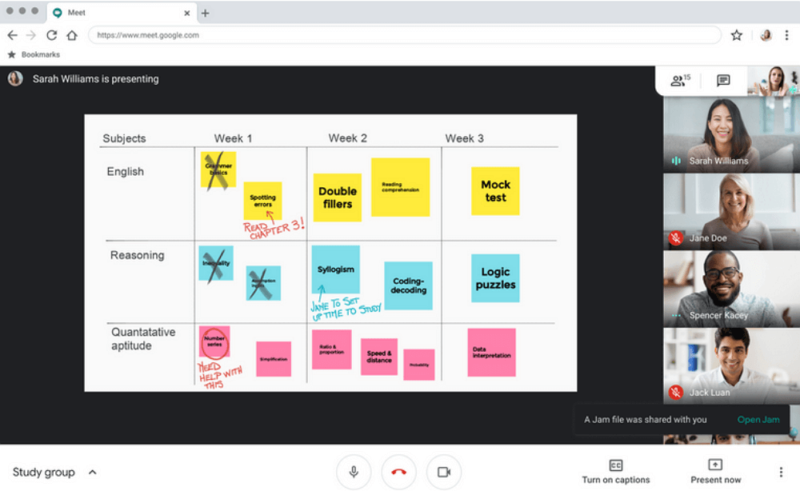
More details about Google Meet:
- Pricing: Free plan available; Paid plans integrated with Google Workspace and starts at $6 per user per month.
- Provider website: meet.google.com
Pros:
- Integrated with Google Workspace
- Many integrations available
- Simple & affordable
Cons:
- Mobile app requires Google account sign-in
- More prone to hacking
Google Meet is an exceptional productivity tool for collaboration because it’s free to use and simple to set up. You can easily invite collaborators via email and share your screen, or initiate a video call by simply clicking a link. Google Meet also offers high-definition audio and video calls, screen-sharing capabilities and other functions that can help you boost productivity.
Google Meet is available for free, where you can host meetings of up to 100 individuals for an hour. The paid versions expand this to 500 individuals and come integrated with Google Workspace.
| Plan: | Price | Storage | Users |
|---|---|---|---|
| Business Starter | $6 | 30GB | 300 |
| Business Standard | $12 | 2TB | 300 |
| Business Plus | $18 | 5TB | 300 |
| Enterprise | Contact Google | Unlimited | Unlimited |
The 5 Best Cloud Storage Tools for Collaboration
If you need a secure place to store, access and share your files online, check out the best cloud storage tools for collaboration. They’re easy to use and integrate well with third-party apps. Here are our handpicked recommendations:
1. Sync.com
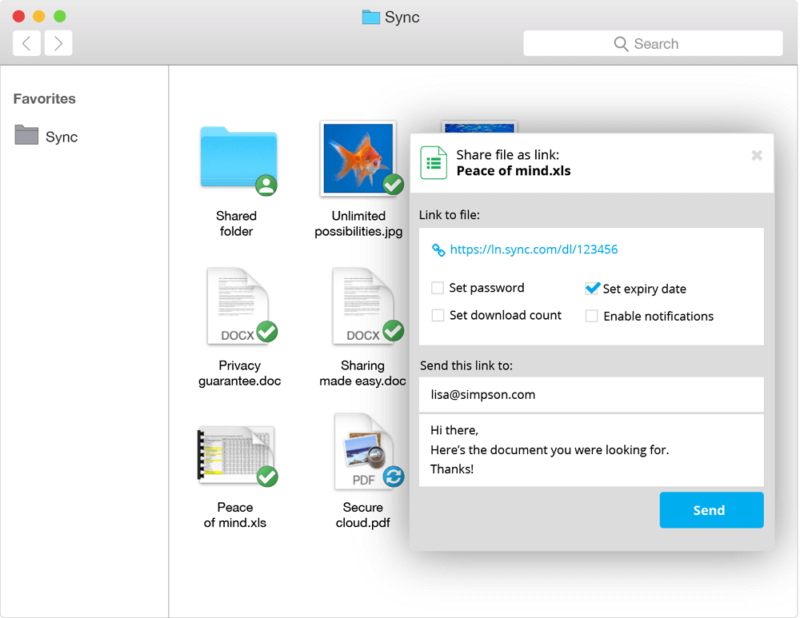
More details about Sync.com:
- Pricing: 5GB free; 1TB for $6 per month (one-year plan) per user per month
- Provider website: sync.com
Pros:
- Advanced sharing option
- Competitively priced plans
- Highly secure
Cons:
- Some sharing options are behind a paywall
- Mediocre speeds
Sync.com is one of the best cloud storage services for collaboration, because it’s secure, reliable and easy to use. It has an intuitive interface that makes sharing files easier than ever before. You can share with one or more people inside or outside your organization and keep everyone on the same page.
What makes Sync.com the best online collaboration software is that it has one of the best file-versioning features, allowing you to share files of all formats, including .docx, .xlsx and .pptx, without special software downloads from third-party apps. Storage is encrypted, so your files can’t be accessed by unauthorized users.
Another thing that makes Sync.com a great cloud storage tool for collaboration is its pricing structure. The free tier offers 5GB of storage; paid team plans start at $72 per month and vary in price depending on how much data you need.
- 5GB
- 2TB
- 6TB
More plans
- Price per user
- 1TB
- Price per user
- Unlimited GB
- Minimum 100 users, custom requirements, account manager, training options
2. Box
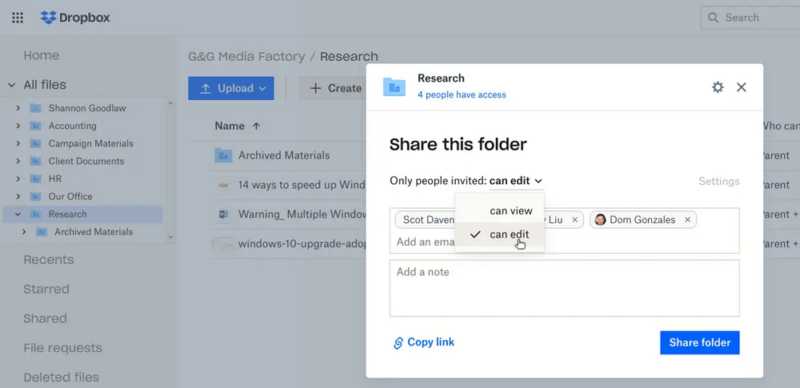
More details about Box:
- Pricing: 10GB free; Unlimited storage for $15 per month (one-year plan), per user
- Provider website: box.com
Pros:
- Great real-time collaboration
- Secure protocols
- Workflow automation
Cons:
- Sync can be buggy
- Lack of offline capabilities
- Limited file/link-sharing
Box is a powerful cloud storage tool that enables employees and remote teams to collaborate and discuss ideas on important projects. With Box, you can share large files and manage projects in the Cloud. Multiple features like mobile editing and easy collaboration have made Box a strong contender in the cloud storage arena.
One feature we like about Box is that you can add DocuSign for e-signatures on all documents. Unlike many other cloud storage solutions, Box also offers an API for developers, so you can easily incorporate it into your existing workflow without having to worry about switching systems entirely.
Box offers a free version with an upload limit of 250MB per file, 10GB of storage and limited functionality. If you need more usability and storage, the various paid plans start at $5 per month.
- Single user
- 10GB
- Single user
- 100GB
- Price per user, minimum of three users
- 100GB
More plans
- Users: No limit
- Unlimited GB
- Users: No limit
- Unlimited GB
- Users: No limit
- Unlimited GB
3. Dropbox

More details about Dropbox:
- Pricing: 2GB free; 2TB for $9.99 per month (one-year plan)
- Provider website: dropbox.com
Pros:
- Excellent sync & sharing
- Tons of integrations
- Scalable storage
Cons:
- Limited resource management
- Relatively expensive
- Only 2GB of default storage
Dropbox is a great cloud storage tool for collaboration because it offers an easy-to-navigate interface, solid security and an overall user-friendly experience. These features make it easy to share files and collaborate with others.
One of its unique features is that you can store photos and videos from your smartphone or tablet in Dropbox for easy access from all of your devices. With this, you can view and share photos and videos with others easily.
Another feature is the ability to share specific folders with people who need access, so you don’t have to share a whole Dropbox account with others if you don’t want to. It’s also easily accessible via the web or mobile apps. This makes it perfect for sharing large files with someone who has multiple devices on various platforms without having to worry about email attachments and passwords.
As mentioned above, the free plan limits you to 2GB of storage. The paid plans start at $11.99 per month and can be scaled based on your usage and storage needs.
- 1 user
- 2GB
- 1 user
- 2TB
- 1 user
- 2TB
More plans
- (Formerly Dropbox One) 1 user Signature requests and eSignature templates
- 3TB
- 3 users minimum
- 5TB
- 3 users minimum
4. Google Drive
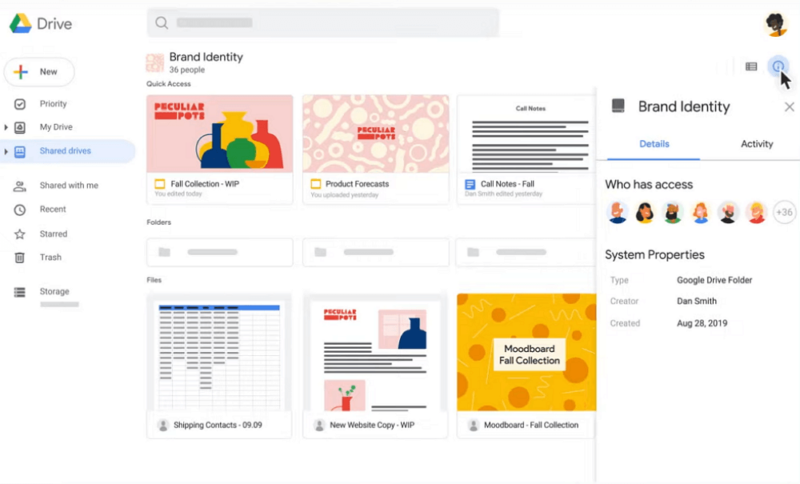
More details about Google Drive:
- Pricing: 15GB free; 2TB for $8.33 per month (one-year plan)
- Provider website: drive.google.com
Pros:
- Integrates with Google Workspace
- Lots of free storage
- Packed with features
Cons:
- Privacy concerns
- No password for link sharing
Google Drive is a great cloud storage tool for collaboration that allows you to work with others on documents, spreadsheets and presentations. One unique feature is the ability to share your link with others, so they can view what you are working on. You can even allow specific people access to download or comment on parts of your Google document by defining their role as Viewer, Commenter or Editor.
Google Drive has a simple user interface that makes sharing and collaborating easy. Another great feature is the Drive Documents tool, which allows users to attach files directly to emails using just their email address and a link. This allows you to share content with your team directly from your email, so it’s automatically saved from the get-go.
Google Drive starts free with limited storage of 15GB. The paid plans and features come integrated with Google’s Workspace plans, or you can buy storage separately as needed, starting from $1.99 per month.
- Free plan
- 15GB
- 100GB
- *The plan is “hidden.” To find the 200GB plan, you need to be subscribed to one of the other plans, upgrade or downgrade to the 200GB through your account’s settings.
- 200GB
More plans
- 2TB
- 2TB
- 5TB
- 10TB
- 20TB
- 30TB
5. Microsoft OneDrive
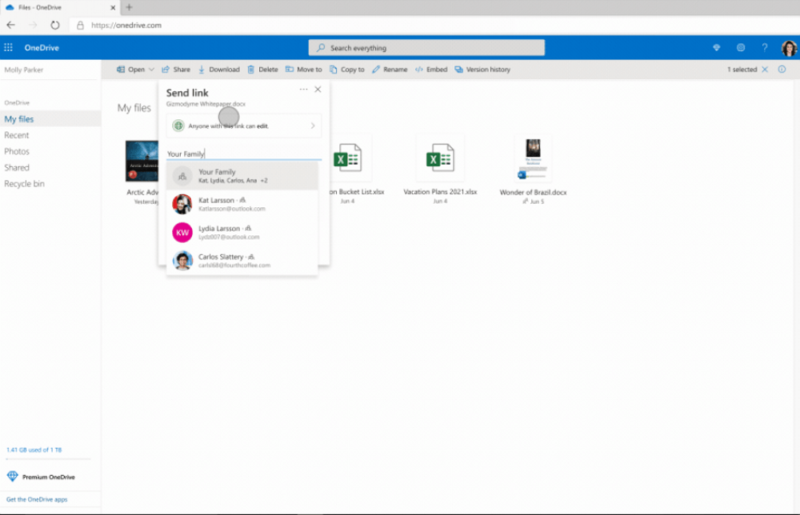
More details about OneDrive:
- Pricing: 5GB free; 1TB for $5 per month (one-year plan)
- Provider website: onedrive.live.com
Pros:
- Full Office 365 integration
- Great for document collaboration
- Fast syncing across devices
Cons:
- Fairly limited support
- Limited file-versioning
OneDrive is a great cloud storage tool for collaboration. It uses a simple web browser or desktop apps to access all your content, making it easy for anyone to use. The OneDrive platform provides enterprise-grade security by integrating with Active Directory domain services to help you manage access, so only employees with proper permissions can access email or view files.
We love that it automatically detects who is working on which document and gives each user access to what they need with the appropriate reading or editing permissions. You can even set up an alert when someone else makes changes. Since OneDrive comes as part of your Microsoft account, it’s easy to use across multiple devices and platforms.
With 5GB of free storage space on Windows and other platforms, it’s one of the best free cloud storage options available, next to Google Drive. OneDrive is available to a variety of users, thanks to its various subscription plans.
- For one person
- 5GB
- 100GB
- Comes with Office 365 Personal
- 1TB
More plans
- Comes with Office 365 Home
- 6TB
- Price per user
- 1TB
- 1TB
- Price per user
- 1TB
Final Thoughts
Cloud collaboration tools are everywhere these days, and while they share many common features, each tool puts its own spin on it. It’s important for small businesses and individuals to know what they are getting while choosing the right software.
As long as you stick to our recommended list, you will be good to go. Overall, Microsoft Office 365 provides you with the best productivity and collaboration features while integrating with tons of everyday work applications like Word, Excel and PowerPoint.
The best option for an online cloud collaboration tool, though, is Sync.com. Its effective and secure cloud storage and seamless uploads and downloads make it an easy recommendation. However, you can’t go wrong with Google Drive or Microsoft OneDrive either.
What’s your choice of productivity and cloud collaboration tool? Did the tool that you’re currently using make the list? Let us know in the comments, and thanks for reading.
FAQ
Cloud collaboration tools are online software platforms that you can use to collaborate with people around the world, and they facilitate working with others on projects and tasks. They typically provide a set of basic features such as text chatting and file-sharing capabilities, and in some cases act as video conferencing tools.
Yes, Dropbox can be used as a cloud collaboration tool. Dropbox allows users to share files and folders with others. It is also possible to share documents on one device with people who have Dropbox installed on their device.



